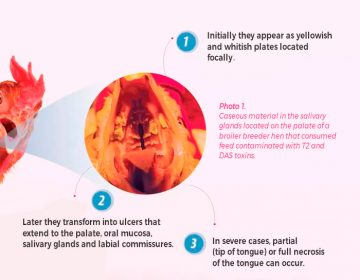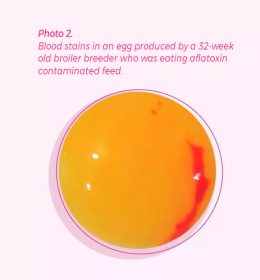Oral lesions
To read more content about aviNews November 2020
To read more content about aviNews November 2020
Contenido disponible en:
Español (Spanish) Português (Portuguese (Brazil))
In this article we will review the most common clinical pictures that we observe in field conditions in commercial and breeding hens, including:
Although liver damage – including fatty liver syndrome – is very common in chickens, we will not include it in this publication.
Oral lesions
They are mostly associated with feed contaminated with mycotoxins and consists of the presence of erosions and ulcers in the oral cavity 
Action mechanisms
Mycotoxins such as T2 Toxin, MAS –monoacetoxiscirpenol–, DAS –diacetoxiscirpenol– and HT 2 toxin –T 2 metabolite– produce these changes through two mechanisms of action:
The first is a caustic effect via direct contact, that damages the epithelium of the oral cavity..
Intestinal absorption of mycotoxins
The second mechanism consists of intestinal absorption of the above-mentioned mycotoxins into the first portion of the small intestine and then transport into the bloodstream. Once in the blood, they are secreted into the oral cavity through the salivary glands and cause injury to the oral tissue again. This latter mechanism explains why when an effective mycotoxin trap is used, a decrease in the degree and number of birds with oral lesions is reported. Occasionally, clinical observations occur in the field where T2 is unsuccessfully identified in feed. However, when testing for DAS or HT 2, the aetiological agents can be identified.
Other agents
Other confusing agents that can also cause oral lesions are mentioned below, although these changes are generally not as severe and typical as those caused by mycotoxins. Feeding the birds very finely ground feed, incorrect use of quaternary ammonium-based disinfectants and strong acidifiers can all cause changes in the appearance of the oral mucosa.
The very fine food will cause these very small particles to deposit easily in different areas of the lip and mouth corners, and may cause the clinician to misdiagnose them as oral lesions.
Finally, in some countries that substitute wheat for corn in the diet, this grain has the tendency to settle in some areas of the mouth and produce deposits that are relatively similar to oral lesions caused by mycotoxins.
The great damage from the point of view of productive efficiency caused by oral injuries is that they decrease the volume of feed consumed and increases the time of consumption.
Increased consumption time is very critical in warm climates and in broiler breeders, who compete voraciously to consume the diet in very few hours. The beak of birds is similar to the lips and teeth of mammals, therefore, any kind of discomfort will affect consumption.

When the differential diagnosis is made by histopathology, there are no typical lesions in the oral cavity that can be associated with the mycotoxins of the trichothecenes group, but typical histopathological changes – thinning of the thymus cortex and lymphoid depletion – do appear in the thymus. In addition to these changes, other lesions in other important organs within the immune system will be identified.
Dietary / nutritional elements
The watery consistency of feces is traditionally associated with the use of poorly processed soybean paste, the inclusion of high levels of salt – sodium – and very high levels of calcium carbonate in the form of powder – not particle – in the ration consumed by commercial laying hens. High levels of magnesium in the diet due to the use of limestone with high Mg levels -more than 1%-, which is known as dolomitic calcium carbonate can also produce the same effect.

They are frequently associated with mycotoxins such as T-2 and DAS, due to the enteritis they cause at the intestinal epithelial level or like Ocratoxin due to their effect on the absorption of fluids through the kidneys. Citrinin, another mycotoxin, can also cause kidney damage, but we do not detect it frequently under commercial conditions. Although Fumonisin and other mycotoxins are associated with disorders of intestinal integrity when high levels of feed are used in experimental tests, in field conditions it is difficult to clearly establish a relationship between this mycotoxin and the presence of lesions in the intestines. What can be established is a negative effect on the productive parameters such as feed conversion, weight gain, etc.
Pathogens
Intestinal infections such as Colibacillosis, Clostridiosis and Salmonellosis are traditionally associated with very wet stools due to the diarrhea they cause. Spirochetes, which are rare in commercial conditions, can also cause diarrhea.
Environment
Among the environmental factors, it is necessary to mention caloric stress that ends up causing excessive water consumption. In some farms they use well water contaminated with high levels of magnesium, potassium or sodium that can cause diarrhea.
Shell quality
Aflatoxin and Ocratoxin can interfere with the absorption of vitamin D3 by the damaging effects on the liver and kidneys respectively. As a consequence, the normal production of 25-hydroxy-D3 and 1,25-dihydroxy-D3 is compromised. Enteritis, at the level of the first portion of the small intestine caused by intoxication with fusariotoxins such as toxin T2, MAS and / or DAS, causes lack of absorption of vitamin D3, calcium and / or phosphorus at the intestinal level, which explains why the shells appear soft.
Eggs of watery consistency
Characterized so because the white presents a consistency similar to that of water, In these cases, the height of the albumin, which is measured in Haugh = HU units, is very low. It can be a product of mycotoxins such as Aflatoxin due to the effect they have on protein synthesis at the liver level. Other management practices that may affect are the following:
The great negative effect of watery stools is the high percentage of dirty eggs and the productive inefficiency of hens, which have to eat more to cover their nutritional needs. Rapid mobilization through the gastrointestinal tract will hinder the absorption of important nutrients.

Blood stains
Blood stains are produced by hemorrhages within the ovarian follicle during ovulation. The small blood vessels located in the ovary rupture when the yolk is released, causing the blood to be transported within the yolk into the oviduct and become part of the egg’s content. These spots are usually located near the bud, although occasionally they spread in the albumin. Mycotoxins can be correlated with many clinical pictures, therefore, it is necessary to consider many of the factors mentioned when making a differential diagnosis.
Meat stains
By contrast, meat spots consist of small sections of tissue – darker than blood spots – produced when small sections of the oviduct are collected by the egg before the shell membranes form. They are usually associated with albumin, not so much with the yolk and can be made up of portions of blood spots or pigments that have been degraded. They can be blood spots produced before ovulation. The breakdown of hemoglobin causes them to be darker in color.
Causes of the spots
The most important causes of blood spots include vitamin K deficiency, Aflatoxin and the presence of red mites. The effect of Aflatoxin on the capillary fragility of blood vessels explains why it increases the incidence of meat and blood stains in chickens that consume contaminated diets. A scientific paper was recently published in Poultry Science, demonstrating the relationship between mycotoxins and a higher incidence of blood and meat stains – Poultry Science 2015, Annual Meeting.